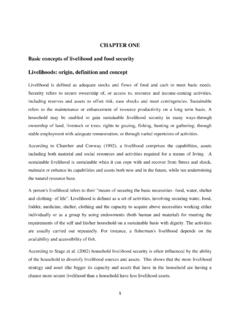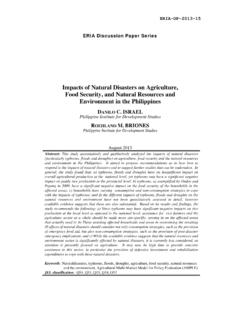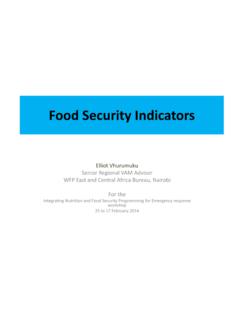Transcription of THE STATE OF FOOD SECURITY AND NUTRITION IN THE …
1 food SECURITY AND NUTRITION IN THE WORLDTHE STATE OF SAFEGUARDING AGAINST ECONOMIC SLOWDOWNS AND DOWNTURNSDEMOCRATIC REPUBLIC OF THE CONGO. Young woman selling fruit at a street PHOTOGRAPH Shutterstock/Valeriya AnufriyevaThis flagship publication is part of THE STATE OF THE WORLD series of the food and Agriculture Organization of the United citation:FAO, IFAD, UNICEF, WFP and WHO. 2019. The STATE of food SECURITY and NUTRITION in the World 2019. Safeguarding against economic slowdowns and downturns. Rome.
2 CC BY-NC-SA designations employed and the presentation of material in this information product do not imply the expression of any opinion whatsoever on the part of the food and Agriculture Organization of the United Nations (FAO), the International Fund for Agricultural Development (IFAD), the United Nations Children s Fund (UNICEF), the World food Programme (WFP) or the World Health Organization (WHO) concerning the legal or development status of any country, territory, city or area or of its authorities, or concerning the delimitation of its frontiers or boundaries.
3 The mention of specific companies or products of manufacturers, whether or not these have been patented, does not imply that these have been endorsed or recommended by FAO, IFAD, UNICEF, WFP or WHO in preference to others of a similar nature that are not mentioned. The designations employed and the presentation of material in the maps do not imply the expression of any opinion whatsoever on the part of FAO, IFAD, UNICEF, WFP or WHO concerning the legal or constitutional status of any country, territory or sea area, or concerning the delimitation of frontiers.
4 All reasonable precautions have been taken by FAO, IFAD, UNICEF, WFP and WHO to verify the information contained in this publication. However, the published material is being distributed without warranty of any kind, either expressed or implied. The responsibility for the interpretation and use of the material lies with the reader. In no event shall FAO, IFAD, UNICEF, WFP and WHO be liable for damages arising from its 978-92-5-131570-5 FAO 2019 Some rights reserved. This work is made available under the Creative Commons Attribution-NonCommercial-ShareAlike IGO licence (CC BY-NC-SA IGO; ).
5 Under the terms of this licence, this work may be copied, redistributed and adapted for non-commercial purposes, provided that the work is appropriately cited. In any use of this work, there should be no suggestion that FAO endorses any specific organization, products or services. The use of the FAO logo is not permitted. If the work is adapted, then it must be licensed under the same or equivalent Creative Commons licence. If a translation of this work is created, it must include the following disclaimer along with the required citation: This translation was not created by the food and Agriculture Organization of the United Nations (FAO).
6 FAO is not responsible for the content or accuracy of this translation. The original English edition shall be the authoritative edition. Any mediation relating to disputes arising under the licence shall be conducted in accordance with the Arbitration Rules of the United Nations Commission on International Trade Law (UNCITRAL) as at present in materials. Users wishing to reuse material from this work that is attributed to a third party, such as tables, figures or images, are responsible for determining whether permission is needed for that reuse and for obtaining permission from the copyright holder.
7 The risk of claims resulting from infringement of any third-party-owned component in the work rests solely with the , rights and licensing. FAO information products are available on the FAO website ( ) and can be purchased through Requests for commercial use should be submitted via: Queries regarding rights and licensing should be submitted to: 2663-8061 food and Agriculture Organization of the United NationsRome, 20192019 SAFEGUARDING AGAINST ECONOMIC SLOWDOWNS AND DOWNTURNSFOOD SECURITY AND NUTRITION IN THE WORLD THE STATE OF | ii |CONTENTSFOREWORD viiMETHODOLOGY xACKNOWLEDGEMENTS xi ACRONYMS AND ABBREVIATIONS xiiiKEY MESSAGES xivEXECUTIVE SUMMARY xviPART 1 food SECURITY AND NUTRITION AROUND THE WORLD IN 2019 Recent trends in hunger and food insecurity Progress towards global NUTRITION targets Towards an integrated understanding of food SECURITY and NUTRITION for health and well-being Conclusions 46
8 PART 2 SUSTAINED ESCAPES FROM food INSECURITY AND MALNUTRITION IN THE FACE OF ECONOMIC SLOWDOWNS AND DOWNTURNS Economic slowdowns and downturns and their impact on food SECURITY and NUTRITION Commodity dependence and its relevance for food SECURITY and NUTRITION Nexus between economic growth, poverty, and food SECURITY and NUTRITION : the role of inequality Policies for achieving sustainable escapes from food insecurity and malnutrition in the context of economic slowdowns and downturns Conclusions 118 ANNEXES 121 ANNEX 1 AStatistical tables to Part 1 122 ANNEX 1 BMethodological notes to statistical tables 148 ANNEX 2 Methodologies Part 1 159 ANNEX 3 PoU change point definitions.
9 Methodology and country lists 165 ANNEX 4 Economic growth and change in PoU between 2011 and 2017 169 ANNEX 5 The main drivers of crisis-level acute food insecurity in 2018 176 ANNEX 6 Commodity dependence definitions and country lists 178 ANNEX 7 Glossary 185 NOTES 191| iii |TABLES, FIGURES AND BOXES TABLES 1 Prevalence of undernourishment (PoU) in the world, 2005 2018 82 Number of undernourished people in the world, 2005 2018 93 Prevalence of moderate or severe food insecurity, and severe food insecurity only, measured with the food Insecurity Experience Scale, 2014 2018 154 Number of people experiencing moderate or severe food insecurity, and severe food insecurity only, measured with the food Insecurity Experience Scale, 2014 2018 185 Association between food insecurity and various forms of malnutrition.
10 Cross-country analysis based on national data 446 Association between food insecurity and overweight or obesity in different age groups: micro-level data analysis from selected countries 457 Association between household food insecurity, child stunting and wasting, and anaemia in women of reproductive age: micro-level data analysis from selected countries 468 Economic shocks were significant secondary and tertiary drivers of food crises in 2018 609 High levels of commodity-export and -import dependence negatively affect food SECURITY 6710 Government spending on social and health sectors and UHC coverage in high commodity-dependent countries 7611 Coping strategies.
















